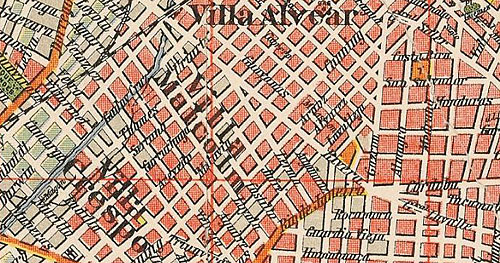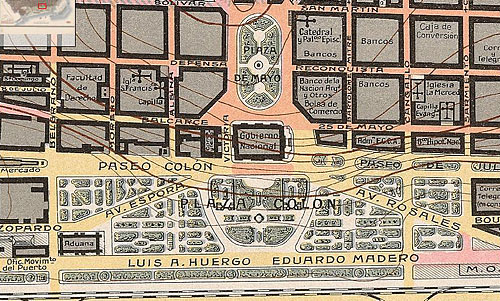April 2008
Monthly Archive
One of my librarian friends back in the U.S. sent me a link to a project by the University of Chicago library: Late 19th- and Early 20th-Century Latin American Cities. Included are digital copies of 2 maps of Buenos Aires held by the University of Chicago Library’s Map Collection.
Like all good online maps these days, these feature that nice zoom-and-pan tool.
Buenos Aires, 1912

This map shows two barrios, Villa Alvear and Villa Malcolm, that have since been re-named as parts of Palermo. Personally, I like the older names.
Since tango is not a part of my Buenos Aires experience (and I don’t really wander around this part of the city too much), I didn’t realize that there is a tango joint called Villa Malcom. And here’s some video of tango dancing at Villa Malcom.
Map of Buenos Aires, 1916

Colorful isn’t it? Plaza Colón looked very nice back in 1916.
The map is quite extensive and covers the entire city, not just the downtown. Note the topographic contour lines showing the elevation.
I find myself at Bar Britanico a lot lately and blogging about its occasional celebrity clientele or El Hipopotamo across the street. But I’ve realized from Google that many people still find my June 2006 posting about the closing of Bar Britanico, which I forgot to update to reflect the re-opening of Britanico….oops.
…A late afternoon photo taken from the window of Bar Britanico, looking out on the intersection of Brasil and Defensa streets.

Another for the City that Fades Away series….
The basta de demoler blog chronicles the demolition of the historic architecture in Buenos Aires. Their posts this last week have been about the illegal demolition of yet another aspect of the city’s cultural heritage, the former Hotel Metropol (Bartolomé Mitre 1618/20).
You should take a look at this video that offers a tour of the interior.
Chad W. Post of the Three Percent blog, an excellent source of information on literature in translation, is in Buenos Aires for the annual book fair and a meeting of foreign editors.
Our schedule is packed”“starting tomorrow morning at 9:30, we have meetings from 10am till 7pm (or later) every day of the week. And no scheduled tango dancing”“all literary meetings.
You can follow his updates.
As someone with Irish ancestry (way, way back), I’ve written a bit before about Irish immigration to Argentina. A great resource for this topic is the wonderful Irish Migration Studies in Latin America (IMSLA).
The latest issue of IMSLA, Sporting Traditions in Latin America and Ireland, focuses largely on Argentina. In his introduction to the issue, guest editor John Kennedy explains
As the articles in this journal demonstrate, the contribution of the Irish and subsequently Irish-Argentines to the sporting landscape was varied and wide-ranging. Many Irish people who worked for British-owned railways or businesses were either co-founders or members of the first sports institutions, initially cricket clubs and later football and rugby clubs.
Even if you don’t have a strong interest in sports, there are a lot of fascinating historical insights about Buenos Aires and Argentina in these well-researched articles.
Who are the legendary figures of Buenos Aires? Obviously, Eva Peron is the most known (along with hubby Juan). Among those who read, Borges is legendary. Among those who dance tango, there’s Gardel.
Buenos Aires has great old architecture but are any of the architects of Buenos Aires really legendary, the likes of Louis Sullivan or Gaudí?
Actually, this really isn’t about Buenos Aires. The main reason behind this post is to provide an opportunity to quote a passage from a novel by James Salter that I’m reading. Light Years (recently reissued by Penguin and with an introduction by Richard Ford) is about the marriage of Viri and Nedra. Viri is a New York architect:
(recently reissued by Penguin and with an introduction by Richard Ford) is about the marriage of Viri and Nedra. Viri is a New York architect:
He could not be Sullivan, he could not be Gaudí. Well, perhaps Gaudí, who lived to that old age which is sainthood, an ascetic old age, frail, slight, wandering the streets of Barcelona, unknown to its many inhabitants. In the end he was struck by a streetcar and left unattended. In the bareness and odor of the charity ward amid the children and poor relations a single eccentric life was ending, a life that was more clamorous than the sea, an everlasting life, a life which was easy to abandon since it was only a husk; it had already metamorphosed, escaped into buildings, cathedrals, legend.
What do you write about when you don’t know what to write? Or, when you’re filled with thoughts, each competing for attention, seeking expression?
I find myself falling back into reading about my favorite historical period, 1880 – 1930. The architecture of Buenos Aires is a vivid reminder of that age, but I’m more and more intrigued by another topic: criminality and mental illness in Buenos Aires, circa 1900.
My reading list includes learning much more about José Ingenieros, one of the leading Argentine criminal psychiatrists, and his mentor José María Ramos Mejia. Along the way I need to re-read a lot of Horacio Quiroga, who did a very good job in his fiction of identifying with the mad. So, over the next few months will be the occasional post about the psychopathology of Buenos Aires a century ago.
Meanwhile, here’s a photo of a somewhat smoky Parque Lezama.

I wish I could draw, but I can’t. If I could draw, then I would spend a lot of time drawing the architecture of Buenos Aires.
The best set of architecture books I’ve seen on any city is on New Orleans, researched and written by the Friends of the Cabildo and produced by Pelican Publishing. While it has been years since I’ve seen one of those books, I remember the great drawings of the buildings. For an example of one of these books, see the Search Inside feature via Amazon New Orleans Architecture Vol V: The Esplanade Ridge
I wish that Buenos Aires had such a nicely produced set of books about this city’s architecture.
But for those who like architectural drawings: out at the School of Architecture, Design, & Urbanism (FADU) of the University of Buenos Aires hangs a set of lovely drawings of some of the best architecture in Buenos Aires.






I spend a lot of my time in Buenos Aires scratching marks on paper…some of it comes out like this.
Last month I posted a photo from the window of El Hipopótamo, looking across Defensa street towards Bar Britanico. So, now here’s the opposite view:

I’ve been neglecting this blog for most of March while I was busy with other projects. But now it’s time to resume regular postings.

